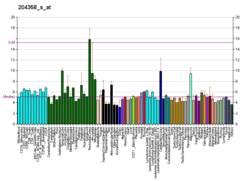FLRT2
Fibronectin leucine-rich repeat transmembrane protein FLRT2 is a protein that in humans is encoded by the FLRT2 gene.[3][4][5]
Function
This gene encodes a member of the fibronectin leucine rich transmembrane protein (FLRT) family. FLRT family members may function in cell adhesion and/or receptor signalling. Their protein structures resemble small leucine-rich proteoglycans found in the extracellular matrix.[5]
References
- ↑ "Human PubMed Reference:".
- ↑ "Mouse PubMed Reference:".
- ↑ Lacy SE, Bönnemann CG, Buzney EA, Kunkel LM (December 1999). "Identification of FLRT1, FLRT2, and FLRT3: a novel family of transmembrane leucine-rich repeat proteins". Genomics. 62 (3): 417–26. PMID 10644439. doi:10.1006/geno.1999.6033.
- ↑ Haines BP, Wheldon LM, Summerbell D, Heath JK, Rigby PW (September 2006). "Regulated expression of FLRT genes implies a functional role in the regulation of FGF signalling during mouse development". Developmental Biology. 297 (1): 14–25. PMID 16872596. doi:10.1016/j.ydbio.2006.04.004.
- 1 2 "Entrez Gene: FLRT2 fibronectin leucine rich transmembrane protein 2".
Further reading
- Zhang Z, Henzel WJ (October 2004). "Signal peptide prediction based on analysis of experimentally verified cleavage sites". Protein Science. 13 (10): 2819–24. PMC 2286551
 . PMID 15340161. doi:10.1110/ps.04682504.
. PMID 15340161. doi:10.1110/ps.04682504. - Ishikawa K, Nagase T, Nakajima D, Seki N, Ohira M, Miyajima N, Tanaka A, Kotani H, Nomura N, Ohara O (October 1997). "Prediction of the coding sequences of unidentified human genes. VIII. 78 new cDNA clones from brain which code for large proteins in vitro". DNA Research. 4 (5): 307–13. PMID 9455477. doi:10.1093/dnares/4.5.307.
- Bonaldo MF, Lennon G, Soares MB (September 1996). "Normalization and subtraction: two approaches to facilitate gene discovery". Genome Research. 6 (9): 791–806. PMID 8889548. doi:10.1101/gr.6.9.791.
This article is issued from
Wikipedia.
The text is licensed under Creative Commons - Attribution - Sharealike.
Additional terms may apply for the media files.

